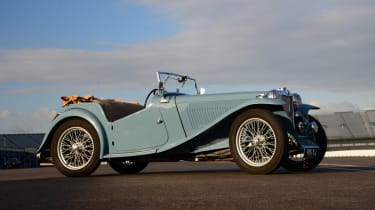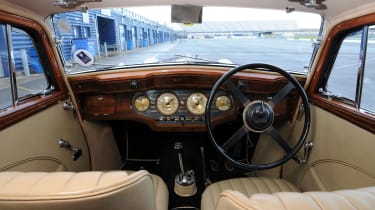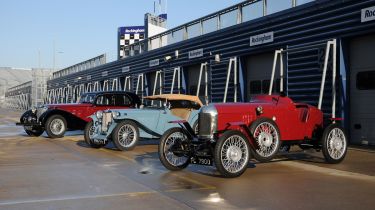1925-1949: MG Old No. 1, MG TC Midget & MG SA
In the hearts and minds of enthusiasts, Old Number One is the car that started the MG legend – but technically it’s not even an MG.
MG Old No.1 - 1925
- Number produced: One
- Price new/now: N/A/priceless
- Engine: 1.5-litre 4cyl, 25bhp 0-60mph/top speed: 20.0 secs/80mph
In the hearts and minds of enthusiasts, Old Number One is the car that started the MG legend – but technically it’s not even an MG.
The cherry red two-seater bears a Morris Garages circular badge rather than the famous MG octagon, and it’s based on a bullnosed Morris Cowley. Even so, it was specially built by MG founder Cecil Kimber for the 1925 competition season, and debuted at the Lands End Trial in Cornwall. Old Number One won the gold medal for a faultless performance at this early equivalent of a special stage rally.
This was one of a number of modified vehicles developed by Kimber and his colleagues between 1924 and 1929. Not only did it lead to the establishment of MG as a separate entity, but the brand’s sporting success caught the general public’s attention and earned it a reputation for building small, affordable performance cars.
Old Number One and other early MGs featured a low chassis and sporty bodywork, including the boat tail design that was popular in the twenties and thirties. And even today, the muscular stance, stripped-down panelling and elongated body look aggressive.
Used - available now

2022 Nissan
Qashqai
13,269 milesManualPetrol1.3L
Cash £22,352
2023 Mercedes
A-Class
27,890 milesAutomaticPetrol1.3L
Cash £19,644
2025 Jaguar
F-Pace
14,169 milesAutomaticDiesel2.0L
Cash £31,910
2021 Nissan
Qashqai
28,211 milesAutomaticPetrol1.3L
Cash £19,902You use a hand crank at the base of the grille to start the light and punchy 1.5-litre four-cylinder petrol engine. Once fired into life, it chugs away noisily, and only delivers 25bhp – similar to a modern 250cc motorcycle. Performance is sluggish by today’s standards, with 0-60mph taking 20 seconds and a top speed of around 80mph. But remember, Old Number One doesn’t have any seatbelts, and relies on skinny tyres and weak drum brakes.
And besides, this two-seater doesn’t need strong pace – as the car that started the MG story, its legendary status is assured.
MG TC Midget - 1945-49

- Number produced: 10,001
- Price new/now: £412/£32,000
- Engine: 1.25-litre 4cyl, 54bhp 0-60mph/top speed: 27.3 secs/78mph
In the thirties, MG clocked up multiple motorsport victories, and its small, high-performance sports cars, nicknamed Midgets, became well known on British race tracks and roads. The TC in our pictures typifies MG’s pre-war roadster design, and stands out among other T-types as the first model to catch the attention of the US market, kick-starting the brand’s post-war transatlantic success story.
Yet World War II forced MG’s Abingdon factory in Oxon to halt production. So when the two-seater cabriolet finally went on sale in 1945, it was built on the same base as 1936’s TA, and had the four-cylinder 1.25-litre engine that had been developed for the TB in 1939.
Rear-hinged doors make climbing into the extremely cramped cabin tricky. The oversized wooden steering wheel doesn’t help, and the tricky fly-off handbrake means this isn’t the easiest car to drive. Still, the TC’s purring 54bhp short-stroke engine delivers a decent turn of speed, despite MG’s claimed 27.3-second 0-60mph time.
The TC’s appeal was always more about fun than performance, though – and probably explains why it found a ready market despite being so obviously dated at launch. In the car’s four-year production run, 10,000 were built, with many bought by GIs returning to the US. These exports started America’s love affair with MG, and laid the foundation for the brand’s fifties and sixties heyday.
MG SA - 1935-39

- Number produced: 2,738
- Price new/now: £415/£60,000-plus
- Engine: 2.3-litre 6cyl, 75bhp 0-60mph/top speed: 14.3 secs/85mph
MG is renowned for its roadsters, but before World War II it also built a number of luxury saloons, such as the imposing four-door SA.
This was the first MG to launch after 1935’s merger with Morris Motors, and its large proportions were a radical departure. The new management disbanded the factory racing team and relegated sports cars to a secondary role, eyeing a new band of wealthy buyers instead.
The SA was based on a Wolseley Super Six, but used a modified chassis and engine. And Cecil Kimber’s rather unaerodynamic design still has plenty of presence. At the end of a long bonnet is a trademark flat MG radiator, flanked by oversized chrome headlamps. Plus, large circular wings around the wheelarches flow into the running boards.
Inside, walnut trim covers the dash and window surrounds, while details include neat condensation grooves under the windows and a polished aluminum security catch to stop the driver selecting reverse accidentally. A fold-down cover on the throttle lets owners drive in different footwear, while small octagon badges feature throughout.
Yet the SA feels cramped inside, particularly in the back, despite its vast size. And with a 1,500kg-plus kerbweight and just 75bhp on tap, it struggles to live up to MG’s sporty reputation: performance is leisurely. But the sense of occasion is priceless and, for a short time, it proved MG could match the world’s best luxury car makers.







